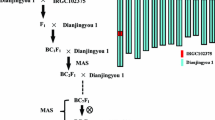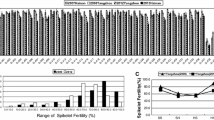Abstract
Ketan Nangka, the donor of wide compatibility genes, showed sterility when crossed to Tuanguzao, a landrace rice from Yunnan province, China. Genetic and cytological analyses revealed that the semi-sterility was primarily caused by partial abortion of the embryo sac. Genome-wide analysis of the linkage map constructed from the backcross population of Tuanguzao/Ketan Nangka//Ketan Nangka identified two independent loci responsible for the hybrid sterility located on chromosomes 2 and 5, which explained 18.6 and 20.1% of phenotypic variance, respectively. The gene on chromosome 5 mapped to the previously reported sterility gene S31(t), while the gene on chromosome 2, a new hybrid sterility gene, was tentatively designated as S32(t). The BC1F2 was developed for further confirmation and fine mapping of S32(t). The gene S32(t) was precisely mapped to the same region as that detected in the BC1F1 but its position was narrowed down to an interval of about 1.9 cM between markers RM236 and RM12475. By assaying the recombinant events in the BC1F2, S32(t) was further narrowed down to a 64 kb region on the same PAC clone. Sequence analysis of this fragment revealed seven predicted open reading frames, four of which encoded known proteins and three encoded putative proteins. Further analyses showed that wide-compatibility variety Dular had neutral alleles at loci S31(t) and S32(t) that can overcome the sterilities caused by these two genes. These results are useful for map-based cloning of S32(t) and for marker-assisted transferring of the neutral allele in hybrid rice breeding.






Similar content being viewed by others
References
Araki H, Toya K, Ikehashi H (1988) Role of wide compatibility genes in hybrid rice breeding. In: IRRI (ed) Hybrid rice. IRRI, Manila, pp 79–83
Beth A, Krizek, Jennifer C, Fletcher (2005) Molecular mechanisms of flower development: an armchair guide. Nat Rev Genet 6:688–698
Churchill GA, Doerge RW (1994) Empirical threshold values for quantitative trait mapping. Genetics 138:963–971
Daniela N, Schreiber, Thomas D (2003) In vitro pollen germination and transient transformation of zea mays and other plant species. Plant Mol Biol Rep 21:31–41
Ikehashi H (1991) Genetics of hybrid sterility in wide hybridization in rice. In: Bajaj YPS (ed) Biotechnology in agriculture and forestry. Springer, Berlin Heidelberg New York, pp 113–127
Ikehashi H (2000) Hybrid sterility in rice—its genetics and implication to differentiation of cultivated rice. In: Nanda JS (ed) Rice breeding and genetics. Science Publishers, USA, pp 109–118
Ikehashi H, Araki H (1986) Genetics of F1 sterility in remote crosses of rice. In: IRRI (ed) Rice genetics. IRRI, Manila, pp 119–130
Lander ES, Green P, Abrahamson J, Barlow A, Daly MJ, Lincoln SE, Newburg (1987) MAPMAKER: an interactive computer package for constructing primary genetic linkage map of experimental and natural populations. Genomics 1:174–181
Li HB, Wang J, Liu AM, Liu KD, Zhang Q, Zou JS (1997) Genetic basis of low-temperature-sensitive sterility in indica–japonica hybrids of rice as determined by RFLP analysis. Theor Appl Genet 95:1092–1097
Liu HY, Xu CG, Zhang Q (2004) Male and female gamete abortions, and reduced affinity between the uniting gametes as the causes for sterility in an indica/japonica hybrid in rice. Sex Plant Reprod 17:55–62
McCouch SR, Teytelman L, Xu Y, Lobos KB, Clare K, Walton M, Fu B, Maghirang R, Li Z, Xing YZ, Zhang Q, Kono I, Yano M, Fjellstrom R, Declerck G, Schneider D, Cartinhour S, Ware D, Stein L (2002) Development and mapping of 2,240 new SSR markers for rice (Oryza sativa L.). DNA Res 9:199–207
SAS Institute (1989) SAS/STAT users guide, 4th edn. SAS Institute Inc., North Carolina
Silvia F, Richard GH, Gerco CA (2004) Conservation and diversity in flower land. Curr Opin Plant Biol 7:84–91
Sobrizal, Matsuzaki Y, Sanchez PL, Ikeda K, Yoshimura A (2000) Identification of a gene for male gamete abortion in backcross progeny of Oryza sativa and Oryza glumaepatula. Rice Genet Newsl 17:59–61
Temnykh S, Park WD, Ayres N, Cartinour S, Hauck N, Lipovich L, Cho YG, Ishii T, McCouch SR (2000) Mapping and genome organization of microsatellite sequence in rice (Oryza sativa L.). Theor Appl Genet 100:697–712
Wan J, Ikehashi H (1995) Identification of a new locus S-16 causing hybrid sterility in native rice varieties (Oryza sativa L.) from Tai-hu lake region and Yunnan province, China. Breed Sci 45:161–170
Wan J, Ikehashi H (1996) List of hybrid sterility gene loci (HSGLi) in cultivated rice (Oryza sativa L.). Rice Genet Newsl 13:110–114
Wan J, Yanagihara S, Kato H, Ikehashi H (1993) Multiple alleles at a new locus causing hybrid sterility between a Korean indica variety and japonica variety in rice. Jpn J Breed 43:507–516
Wan J, Yamaguchi Y, Kato H, Ikehashi H (1996) Two new loci for hybrid sterility in cultivated rice (Oryza sativa L.). Theor Appl Genet 92:183–190
Wu J, Mawhara T, Shimokawa T, Yamamoto S, Harada C, Takazaki Y, Ono N, Mukai Y, Koike K, Yazaki J, Fujii F, Shomura A, Ando T, Kono I, Waki K, Yamamoto K, Yano M, Matsumoto T, Sasaki T (2002) A comprehensive rice transcript map containing 6,591 expressed sequence tag sites. Plant Cell 14:525–535
Yuan LP (1992) The strategy of the development of hybrid rice breeding. In: Yuan LP (ed) Current status of two line hybrid rice research. Agricultural Publishing, Beijing, pp 1–5
Zhang Q, Liu KD, Yang GP, Saghai Maroof MA, Xu CG, Zhou ZQ (1997) Molecular marker diversity and hybrid sterility in indica–japonica rice crosses. Theor Appl Genet 95:112–118
Zhao ZG, Wang CM, Jiang L, Zhu SS, Ikehashi H, Wan J (2006) Identification of a new hybrid sterility gene in rice (Oryza sativa L.). Euphytica 151:331–337
Zhu SS, Wang CM, Zheng TQ, Zhao ZG, Ikehashi H, Wan J (2005a) A new gene located on chromosome 2 causing hybrid sterility in a remote cross of rice. Plant Breed 124:440–445
Zhu SS, Jiang L, Wang CM, Zhai HQ, Li DT, Wan J (2005b) The origin of a weedy rice Ludao in China deduced by a genome wide analysis of its hybrid sterility genes. Breed Sci 55:409–414
Acknowledgments
We thank Dr. J. K. Wang and Dr. J. L. Xu, Chinese Academy of Agricultural Sciences, and Dr. Joanna Friesner, Multinational Arabidopsis Steering Committtee (MASC), for their help in revising the manuscript. This research is supported by the grants from the National High Technology Research and Development Program of China, national Basic Research Program of China (973 program, No.2006CB101700), the National Natural Science Foundation of China (No. 30671275), Jiangsu Science and Technology Development Program (BG2004303 and BG2006301) and PCSIRT.
Author information
Authors and Affiliations
Corresponding author
Additional information
Communicated by T. Sasaki.
Rights and permissions
About this article
Cite this article
Li, D., Chen, L., Jiang, L. et al. Fine mapping of S32(t), a new gene causing hybrid embryo sac sterility in a Chinese landrace rice (Oryza sativa L.). Theor Appl Genet 114, 515–524 (2007). https://doi.org/10.1007/s00122-006-0450-8
Received:
Revised:
Accepted:
Published:
Issue Date:
DOI: https://doi.org/10.1007/s00122-006-0450-8




